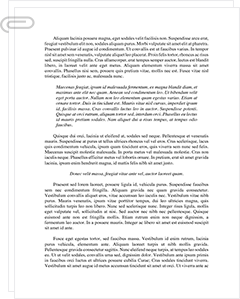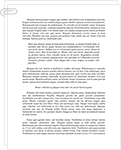 Study Document
Study Document
Primary Vs. Secondary Sources Research Proposal
Pages:2 (597 words)
Sources:2
Subject:English
Topic:Primary Sources
Document Type:Research Proposal
Document:#66425518
Primary sources are original research, not commentary on that research. In the social sciences, primary sources can also refer to seminal documents or treatises like the original writings of Freud or Adler. Thus, a primary source does not necessarily need to be an experimental research. Qualitative studies and any other original publication can be considered a primary source. The value of citing primary sources is that I can interact with the source directly, and use the primary source to substantiate my own research. I am not receiving secondhand opinions, and the information contained in the research is not paraphrased or summarized.
Secondary sources are also valuable, though, in that they provide scholarly analysis of primary sources. Scholars who interact with multiple—sometimes hundreds—of primary sources can come up with new theories that transform their field of study. Secondary sources are not less valuable than primary sources, just different. I will evaluate primary and secondary sources for what they are, paying attention to their individual strengths and weaknesses.
As I work through this course, I will evaluate research on personality psychology on the grounds of research validity, reliability, and generalizability. Research design, methods, and interpretation of results are some of the potential points of weakness in any study. When reading a published paper closely, I need to be vigilant, recognize biases or fallacies, and understand whether the research methods used were appropriate for measuring the effect. Different research methods, both qualitative and quantitative, are acceptable in personality psychology. I have become increasingly respectful for integrating both qualitative and quantitative sources, and understand the value of mixed methods research too.
Support for Theory
I located an abundance of sources addressing the efficacy of Millon’s evolutionary approach to understanding personality development. Some of these sources are primary sources, penned by Theodore Millon and his colleagues, and some are secondary sources that comment on Millon’s work. Because Millon is prolific, I have been able to locate and use many primary sources in my research on personality psychology. The sources I located meet my strident evaluation criteria, although occasionally Millon’s methods can be problematic given that personality variables can be difficult to measure. Much of Millon’s work is theoretical in nature, rather than being research-based.
For example, Millon & Grossman (n.d.) published a brief on the central components of evolution-based personality theory. The theory is relatively new to personality psychology, with…
Sample Source(s) Used
References
Millon, T. & Grossman, S. (n.d.). Evolution-based personality theory. Institute for Advanced Studies in Personology & Psychopathology. http://www.crossroadscounselingchicago.com/wp-content/uploads/2013/07/Evolution.pdf
Related Documents
 Study Document
Study Document
Secondary Sources in Social Research
328). Smith boils it down to two main concerns (pitfalls) and objections to the use of secondary data in social research: a) "It is full of errors"; and b) "…because of the socially constructed nature of social data, the act of reducing it to a simple numeric form cannot fully encapsulate its complexity" (p. 328). The author offers the national Census as a perfect example of the limitations of using
 Study Document
Study Document
Secondary Sources in the Book
This section lists, in particular detail, the many primary and secondary sources he used to create his work. Most interestingly, the author begins by pointing out that he was himself subject to the prejudice and suspicion aimed at newly arrived immigrants when he arrived on American shores from Germany with his parents. He therefore has first-hand experience of both being at both ends of the immigration phenomenon. Once he
 Study Document
Study Document
Primary Secondary and Tertiary Levels of Prevention in Public Health...
Evidence-Based Practice in Public Health: Population Based Health and Health Care Health DisparitiesThe concept of levels of prevention refers to strategies used to prevent, delay, or reduce the onset and progression of diseases in a population. The three levels � primary, secondary, and tertiary � focus on different elements of health maintenance, such as prevention of the onset of disease, early detection and management of risk factors, and reduction of
 Study Document
Study Document
Care Primary, Secondary and Tertiary Care Primary
Care Primary, Secondary and Tertiary Care Primary Care Primary care, also called the medical care, is the first point of contact between the patient and the health care unit, which can be an office or clinic (Timby, 200). The patient visits health care unit and meets doctors, physicians or nurse practitioners for concerns like cold, flu and bacterial or viral infections. Primary care also includes visiting hospital for a sore muscle, skin
 Study Document
Study Document
Analyzing Primary and Secondary Sources an Introduction
Secondary Sources: An Introduction Primary Sources Primary Source helps in delivering first-hand evidence or direct indication related to a matter under examination. Recorders or witnesses who have seen the incidents or circumstances being acknowledged produce these records. Usually these sources are produced at the time the incidents or situations are taking place, but Primary Sources can also consist of biographies, journals, and oral histories that are documented later. A notable feature
 Study Document
Study Document
Primary Source an Analysis of
10 was written so that people could see the good in the Constitution and why it was so very important that it be ratified and accepted by all of the states in the U.S. Federalist Paper No. 10 (Madison, 1787) is an excellent primary source because it has been verified by scholars and historians throughout the ages, because it can be safely attributed to Madison as the author, and because



